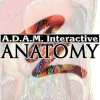
Digital Citizenship Week is October 20–24!
Join teachers worldwide to promote a healthy, positive approach to media and tech.
Take a look inside 5 images
A.D.A.M. Interactive Anatomy
Pros: Assessments, digital dissection tools, and stellar 3-D viewing features help kids move beyond memorization.
Cons: A hefty subscription cost might deter some users.
Bottom Line: A stellar tool that tops other 3-D interactive anatomy sites with its extensive curriculum-building capabilities.
A.D.A.M. Interactive Anatomy curriculum can be tailored for traditional, online, or blended classrooms. While the Directed Interactive Learning Paths allow users to work individually at their own pace, it's important to provide opportunities for students to make sense of the content together. A tool like A.D.A.M. lets teachers on a traditional schedule flip their classroom so that homework time can be spent learning the structures and functions of the body. Then teachers can make the most of their actual classroom time, letting kids work together to figure out how the systems and parts of the body interact. In addition to sharing their digital images, students could work in groups with large whiteboards to map out their conclusions and share with the rest of the class.
A.D.A.M. Interactive Anatomy is an anatomy curriculum development tool. Teachers can select and create assignments that allow students to manipulate 3-D images of the human body. The tool can also be used as a reference tool with a Multimedia Encyclopedia containing more than 3,000 3-D images and more than 3,900 articles. The 3-D Dissection tool is simply a way to digitally peel away the layers of anatomy. Human bodies are available in four different skin tones, as male or female, and with parts labeled in nine different languages. Users can create and share their own visualizations of the human body using the highlight, import, and export capabilities.
A.D.A.M. has all the features for exploring and learning about anatomy and physiology featured in other stellar tools like BioDigital Human and Zygote Body that have similar 3-D capabilities. This tool stands out, though: Beyond the interactive images, there's a full curriculum (based on Directed Interactive Learning Paths) that teachers can customize to their own course objectives and contexts. The included paths allow students to work independently at their own pace, and instructors can build on this massive amount of content (which focuses on everything from basic facts to clinical relevance) to create their own handouts, worksheets, or presentations.
While the Lab Exercises are nothing more than simple drag-and-drop labeling assessments, they helpfully provide immediate feedback for users. It would be even better if there were a variety of assessment types that would let students dig even deeper. As it is, students can see how they did on each question and email their results to the instructor. While the site's subscription cost may seem expensive for teachers and/or students, it's worth considering the analogous cost of alternatives with similar classroom value: A physical model could cost upwards of $500, and this tool offers similar benefits plus assessments, immediate feedback, and reference information. Overall, this is a pricey but high-value tool for the high school science classroom.













